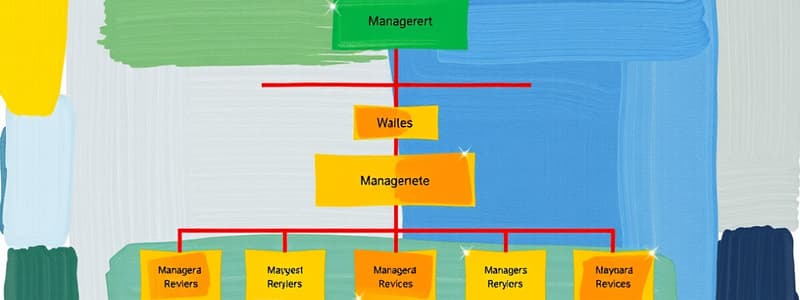Podcast
Questions and Answers
Match the level of managers with their responsibilities:
Match the level of managers with their responsibilities:
Top Managers = Formulate long-term strategies and scan the environment Middle Managers = Execute company directions within departments Front-line Managers = Supervise and support work efforts of employees C-Level Managers = Responsible for the overall performance of the organization
Match the managerial titles with their respective levels:
Match the managerial titles with their respective levels:
Chief Executive Officer = Top Manager Division Manager = Middle Manager Regional Manager = Middle Manager Plant Manager = Front-line Manager
Match the term with its definition:
Match the term with its definition:
Mission Statement = Defines the organization's purpose and primary objectives Vision Statement = Describes the desired long-term future of the organization Top Managers = Responsible for the overall strategic direction Middle Managers = Bridge between top management and employees in specific departments
Match the managerial roles with their main focus:
Match the managerial roles with their main focus:
Match the managerial functions with their descriptions:
Match the managerial functions with their descriptions:
Match the following types of managers with their descriptions:
Match the following types of managers with their descriptions:
Match the following departments with their primary functions:
Match the following departments with their primary functions:
Match the following managerial roles to their typical environments:
Match the following managerial roles to their typical environments:
Match the following managerial roles with their primary responsibilities:
Match the following managerial roles with their primary responsibilities:
Match each type of manager with an example of their role:
Match each type of manager with an example of their role:
Flashcards are hidden until you start studying
Study Notes
Definition of a Manager
- A manager supports, activates, and consolidates work efforts of others.
- Responsible for the performance of group members in an organization.
Levels of Managers
Top Managers
- Includes Chief Executive Officer, President, and Vice President.
- Responsible for overall organizational performance.
- Scan the environment and formulate long-term strategies.
- Also referred to as C-Level managers.
- Mission Statement: Innovate in sports, promote sustainability, build diverse teams, impact communities positively.
- Vision Statement: Inspire and innovate for every athlete globally.
Middle Managers
- Intermediate level between top management and front-line employees.
- Execute company strategies and directives in their departments.
First-Level Managers
- Supervise operations within small workgroups of non-managerial employees.
- Includes roles like Team Leaders.
Types of Managers
Line Managers
- Directly responsible for work that contributes to organizational outputs.
- Have authority over immediate subordinates.
Staff Managers
- Provide specialized expertise and support to line managers.
- Example: Home Resource Manager.
Functional Managers
- Supervise subordinates within specialized single areas.
- Examples of Departments:
- Financial Department: Manages company finances, budgets, and accounting.
- Human Resources Department: Manages employee orientation and workplace integration.
- Marketing Department: Promotes products and converts leads into clients.
General Managers
- Oversee activities across multiple functional areas.
- Example: A plant manager supervising various specialized departments.
Administrators
- Perform managerial functions within public, governmental, educational, and nonprofit organizations.
Studying That Suits You
Use AI to generate personalized quizzes and flashcards to suit your learning preferences.



